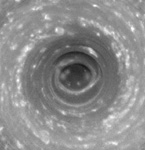Looking Saturn in the Eye

Click on the image for movie of
Looking Saturn in the Eye
Cassini stares deep into the swirling hurricane-like vortex at Saturn's south pole, where the vertical structure of the clouds is highlighted by shadows. Such a storm, with a well-developed eye ringed by towering clouds, is a phenomenon never before seen on another planet.
This 14-frame movie shows a swirling cloud mass centered on the south pole, around which winds blow at 550 kilometers (350 miles) per hour. The frames have been aligned to make the planet appear stationary, while the sun appears to revolve about the pole in a counterclockwise direction. The clouds inside the dark, inner circle are lower than the surrounding clouds, which cast a shadow that follows the sun.
At the beginning of the movie, the sun illuminates directly from the top, and by the end it illuminates from the left.
The width of the shadow and the height of the sun above the local horizon yield a crude estimate of the height of the surrounding clouds relative to the clouds in the center. The shadow-casting clouds tower 30 to 75 kilometers (20 to 45 miles) above those in the center. This is two to five times greater than the tallest terrestrial thunderstorms and two to five times the height of clouds surrounding the eye of a terrestrial hurricane. Such a height difference arises because Saturn's hydrogen-helium atmosphere is less dense at comparable pressures than Earth's atmosphere, and is therefore more distended in the vertical dimension.
The south polar storm, which displays two spiral arms of clouds extending from the central ring and spans the dark area inside a thick, brighter ring of clouds, is approximately 8,000 kilometers (5,000 miles) across, which is considerably larger than a terrestrial hurricane.
Eye-wall clouds are a distinguishing feature of hurricanes on Earth. They form where moist air flows inward across the ocean's surface, rising vertically and releasing a load of precipitation around an interior circular region of descending air, which is the eye itself.
Though it is uncertain whether moist convection is driving this storm, as is the case with Earthly hurricanes, the dark 'eye' at the pole, the eye-wall clouds and the spiral arms together indicate a hurricane-like system. The distinctive eye-wall clouds especially have not been seen on any planet beyond Earth. Even Jupiter's Great Red Spot, much larger than Saturn's polar storm, has no eye, no eye-wall, and is relatively calm at the center.
This giant Saturnian storm is apparently different from hurricanes on Earth because it is locked to the pole, does not drift around like terrestrial hurricanes and because it does not form over liquid water oceans.
The images were acquired over a period of three hours on Oct. 11, 2006, when Cassini was approximately 340,000 kilometers (210,000 miles) from Saturn. Image scale is about 17 kilometers (11 miles) per pixel. The images were taken with the wide-angle camera using a spectral filter sensitive to wavelengths of infrared light centered at 752 nanometers. All frames have been contrast enhanced using digital image processing techniques. The unprocessed images show an oblique view toward the pole, and have been reprojected to show the planet from a perspective directly over the south pole.
The Cassini-Huygens mission is a cooperative project of NASA, the European Space Agency and the Italian Space Agency. The Jet Propulsion Laboratory, a division of the California Institute of Technology in Pasadena, manages the mission for NASA's Science Mission Directorate, Washington, D.C. The Cassini orbiter and its two onboard cameras were designed, developed and assembled at JPL. The imaging operations center is based at the Space Science Institute in Boulder, Colo.
For more information about the Cassini-Huygens mission visit http://saturn.jpl.nasa.gov/. The Cassini imaging team homepage is at http://ciclops.org.
